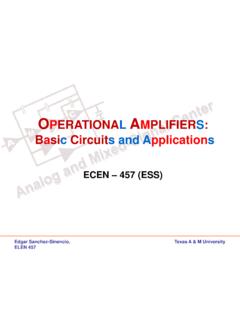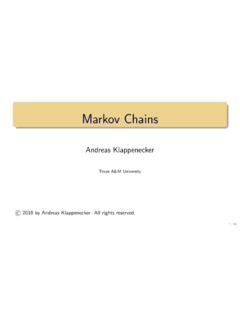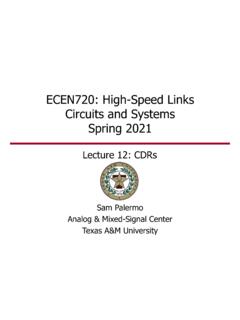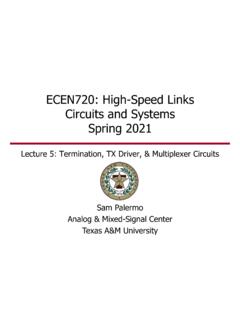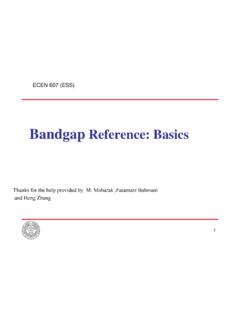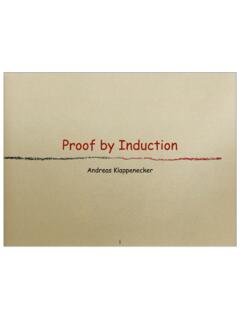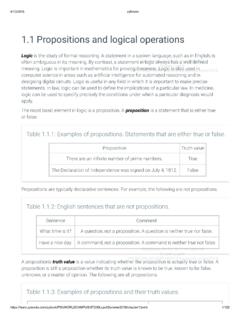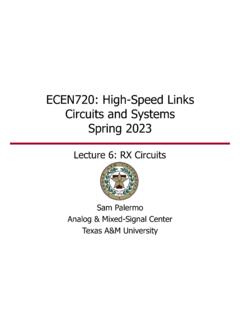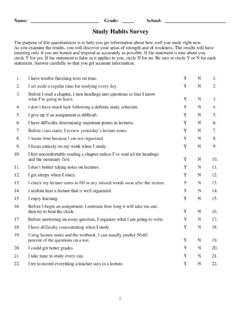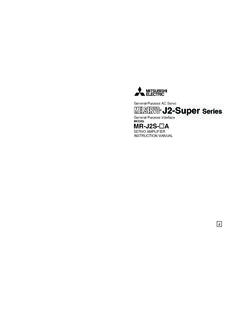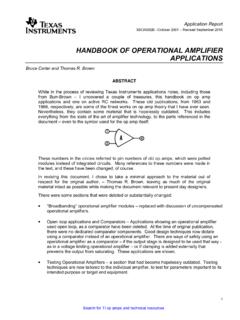Transcription of ECEN720: High-Speed Links Circuits and Systems Spring 2021
1 Sam PalermoAnalog & Mixed-Signal CenterTexas A&M UniversityECEN720: High-Speed Links Circuits and SystemsSpring 2021 Lecture 8: RX FIR, CTLE, DFE, & Adaptive Lab 5 Report due Mar. 24 Friday lecture is on Thursday Mar. 18 (Redefined Day) Equalization overview and Circuits papers are posted on the website2 Agenda RX FIR equalization RX CTLE equalization RX DFE equalization Equalization adaptation techniques Advanced modulation/other techniques3 Link with Equalization4 SerializerDeserializerTX FIR Equalization5 TX FIR filter pre-distorts transmitted pulse in order to invert channel distortion at the cost of attenuated transmit signal (de-emphasis)RX FIR Equalization Delay analog input signal and multiply by equalization coefficients Pros With sufficient dynamic range, can amplify high frequency content (rather than attenuate low frequencies)
2 Can cancel ISI in pre-cursor and beyond filter span Filter tap coefficients can be adaptively tuned without any back-channel Cons Amplifies noise/crosstalk Implementation of analog delays Tap precision6[Hall]RX Equalization Noise Enhancement Linear RX equalizers don t discriminate between signal, noise, and cross-talk While signal-to-distortion (ISI) ratio is improved, SNR remains unchanged7[Hall]Analog RX FIR Equalization Example8D. Hernandez-Garduno and J. Silva-Martinez, A CMOS 1Gb/s 5-Tap Transversal Equalizer based on 3rd-Order Delay Cells," ISSCC, 2007. 5-tap equalizer with tap spacing of Tb/21Gb/s experimental results3rd-order delay cellDigital RX FIR Equalization Digitize the input signal with High-Speed low/medium resolution ADC and perform equalization in digital domain Digital delays, multipliers, adders Limited to ADC resolution Power can be high due to very fast ADC and digital filters9[Hanumolu]Digital RX FIR Equalization Example10[Harwood ISSCC 2007] Flash ADC in 65nm CMOS 2-tap FFE & 5-tap DFE XCVR power (inc.)
3 TX) = 330mW, Analog = 245mW, Digital = 85mWAgenda RX FIR equalization RX CTLE equalization RX DFE equalization Equalization adaptation techniques Advanced modulation/other techniques11 Link with Equalization12 SerializerDeserializerRX Continuous-Time Linear Equalizer (CTLE) Passive R-C (or L) can implement high-pass transfer function to compensate for channel loss Cancel both precursor and long-tail ISI Can be purely passive or combined with an amplifier to provide gain13 Din-Din+Vo-Vo+Passive CTLEA ctive CTLE[Hanumolu]Passive CTLE Passive structures offer excellent linearity, but no gain at Nyquist frequency14 2112212112122121211121212111212,1,111 CCCRRRCCCRRRCCRRRRCRsCCRRRRsCRRRRsHzpz gain DCgain HFPeakinggain HF gain DC p[Hanumolu]Active CTLE Input amplifier with RC degeneration can provide frequency peaking with gain at Nyquist frequency Potentially limited by gain-bandwidth of amplifier amplifier must be designed for input linear range Often TX eq.
4 Provides some low frequency attenuation Sensitive to PVT variations and can be hard to tune Generally limited to 1st-order compensation15 21,211,21,112111 SmzpDmSmDmpDSSSmSSzpDSSSmSSpmRgRgRgRgCRC RRgCRCRsCRRgsCRsCgsH gain DCgain peak IdealPeaking Idealgain peak Ideal gain DC p2p1[Gondi JSSC 2007]Active CTLE Example16 Din-Din+Vo-Vo+Active CTLE Tuning Tune degeneration resistor and capacitor to adjust zero frequency and 1stpole which sets peaking and DC gain17 CSRSSSSmSSzCRRgCR21,1 p1 Increasing CS moves zero and 1stpole to a lower frequency w/o impacting (ideal) peaking Increasing RS moves zero to lower frequency and increases peaking (lowers DC gain) Minimal impact on 1stpoleAgenda RX FIR equalization RX CTLE equalization RX DFE equalization Equalization adaptation techniques Advanced modulation/other techniques18 Link with Equalization19 SerializerDeserializerRX Decision Feedback Equalization (DFE) DFE is a non-linearequalizer Slicer makes a symbol decision, quantizes input ISI is then directly subtracted from the incoming signal via a feedback FIR filter20 nknnknkkkdwdwdwyz ~1~11~1 RX Decision Feedback Equalization (DFE)
5 Pros Can boost high frequency content without noise and crosstalk amplification Filter tap coefficients can be adaptively tuned without any back-channel Cons Cannot cancel pre-cursor ISI Chance for error propagation Low in practical Links (BER=10-12) Critical feedback timing path Timing of ISI subtraction complicates CDR phase detection21 nknnknkkkdwdwdwyz ~1~11~1 [Payne]DFE Example22 If only DFE equalization, DFE tap coefficients should equal the unequalized channel pulse response values [ an] With other equalization, DFE tap coefficients should equal the pre-DFE pulse response values DFE provides flexibility in the optimization of other equalizer Circuits , you can optimize a TX equalizer without caring about the ISI terms that the DFE will take care ofa1a2[w1w2]=[a1a2]Direct Feedback DFE Example (TI)
6 4-tap DFE rate architecture Adaptive tap algorithm Closes timing on 1st tap in UI for convergence of both adaptive equalization tap values and CDR23 TAP1 LatchLatchLatchTAP2 TAP4 TAP3 LatchLatchLatchA2A2 VDDRXEQRXINCLK0/180 CLK90/270 DFECLKto demuxto demuxA1 TAP1: 5 bitsTAP2: 4 bits + signTAP3,4: 3 bits + signFeedback tap muxR. Payne et al, A Binary Transceiver in CMOS for Serial Data Transmission Across High Loss Legacy Backplane Channels, JSSC, vol. 40, no. 12, Dec. 2005, pp. 2646-2657 Direct Feedback DFE Critical Path Must resolve data and feedback in 1 bit period TI design actually does this in UI for CDR24A2A1 UItttPROPAPROPMUXQSACLK12 [Payne]DFE Loop Unrolling Instead of feeding back and subtracting ISI in 1UI Unroll loop and pre-compute 2 possibilities (1-tap DFE) with adjustable slicer threshold With increasing tap number, comparator number grows as 2#taps25ykdk|dk-1=-1dk|dk-1=1dk-1 1sgn1sgn1~11~1~kkkkkdwydwyd if"" if"" [Stojanovic]dk|dk-1=-1dk|dk-1=1 =w1 DFE Resistive-Load Summer Summer performance is critical for DFE operation Summer must settle within a certain level of accuracy (>95%)
7 For ISI cancellation Trade-off between summer output swing and settling time Can result in large bias currents for input and taps26 RCIR ,SwingSummer [Park]DFE Integrating Summer Integrating current onto load capacitances eliminates RC settling time Since T/C > R, bias current can be reduced for a given output swing Typically a 3x bias current reduction27[Park ISSCC 2007]Digital RX FIR & DFE Equalization Example28[Harwood ISSCC 2007] Flash ADC in 65nm CMOS 2-tap FFE & 5-tap DFE XCVR power (inc. TX) = 330mW, Analog = 245mW, Digital = 85mWDFE with Feedback FIR Filter29[Liu ISSCC 2009] DFE with 2-tap FIR filter in feedback will only cancel ISI of the first two post-cursors Smooth Channel30[Liu ISSCC 2009] A DFE with FIR feedback requires many taps to cancel ISI Smooth channel long-tail ISI can be approximated as exponentially decaying Examples include on-chip wires and silicon carrier wires teH 2 DFE with IIR Feedback31[Liu ISSCC 2009] Large 1stpost-cursor H1 is canceled with normal FIR feedback tap Smooth long tail ISI from 2ndpost-cursor and beyond is canceled with low-pass IIR feedback filter Note.
8 Channel needs to be smooth (not many reflections) in order for this approach to work wellDFE with IIR Feedback RX Architecture32[Liu ISSCC 2009] Integrating summer with regeneration PMOS devices to realize partial slicer operationMerged Summer & Partial Slicer33[Liu ISSCC 2009] Low-pass response (time constant) implemented by RDand CD Amplitude controlled by RDand ID 2 UI delay implemented through mux to begin cancellation at 2ndpost-cursorMerged Mux & IIR Filter34[Liu ISSCC 2009]Agenda RX FIR equalization RX CTLE equalization RX DFE equalization Equalization adaptation techniques Advanced modulation/other techniques35 Setting Equalizer Values Simplest approach to setting equalizer values (tap weights, poles, zeros)
9 Is to fix them for a specific system Choose optimal values based on lab measurements Sensitive to manufacturing and environment variations An adaptive tuning approach allows the optimization of the equalizers for varying channels, environmental conditions, and data rates Important issues with adaptive equalization Extracting equalization correction (error) signals Adaptation algorithm and hardware overhead Communicating the correction information to the equalizer circuit36TX FIR Adaptation Error Extraction While we are adapting the TX FIR, we need to measure the response at the receiver input Equalizer adaptation (error) information is often obtained by comparing the receiver input versus the desired symbol levels, dLev This necessitates additional samplers at the receiver with programmable threshold levels37[Stojanovic JSSC 2005]TX FIR Adaptation Algorithm The sign-sign LMS algorithm is often used to adapt equalization taps due to implementation simplicity38 dLevedknwedwwnnnknwknkn level, data desired respect to error withdata, received index, tap instant, time ts,coefficien tapsignsign1 As the desired data level is a function of the transmitter swing and channel loss, the desired data level is not necessarily known and should also be adapted ndLevnnedLevdLevsign1 [Stojanovic JSSC 2005]
10 TX FIR Common-Mode Back-Channel In order to communicate FIR tap update information back to the TX, a back-channel is necessary One option is to use low data rate (~10Mb/s) common-mode signaling from the RX to TX on the same differential channel39[Stojanovic JSSC 2005]TX FIR Data Encoder Back-Channel Another option is to use a High-Speed TX channel on the RX side that communicates data back to the TX under adaptation Flexibility in data encoding (8B10B/Q) allows low data rate tap adaptation information to be transmitted back without data rate overhead40[Stonick JSSC 2003]CTLE Tuning with PSD Measurement One approach to CTLE tuning is to compare low-frequency and high-frequency spectrum content of random data For ideal random data, there is a predictable ratio between the low-frequency power and high-frequency power The error between these power components can be used in a servo loop to tune the CTLE41[Lee JSSC 2006]
